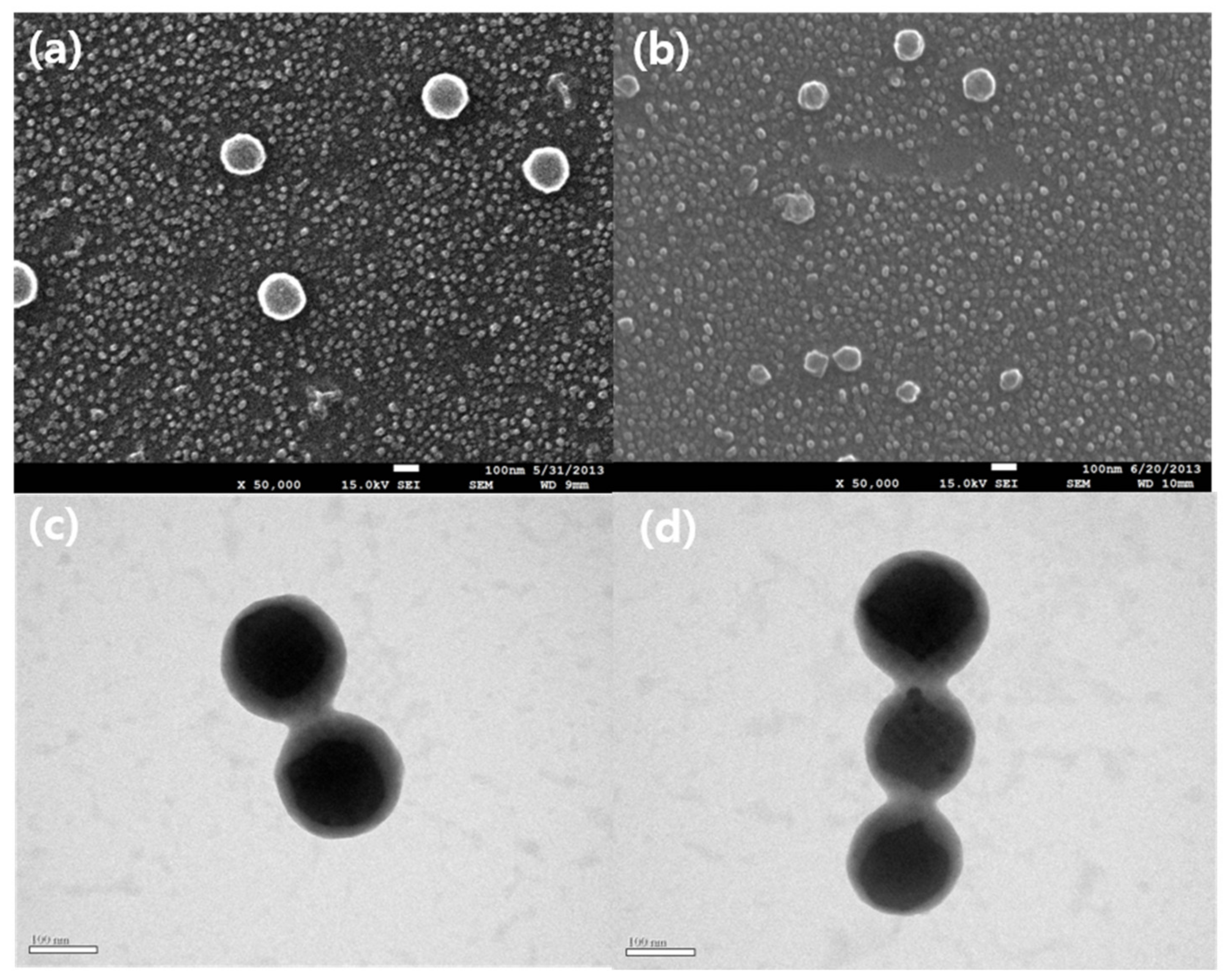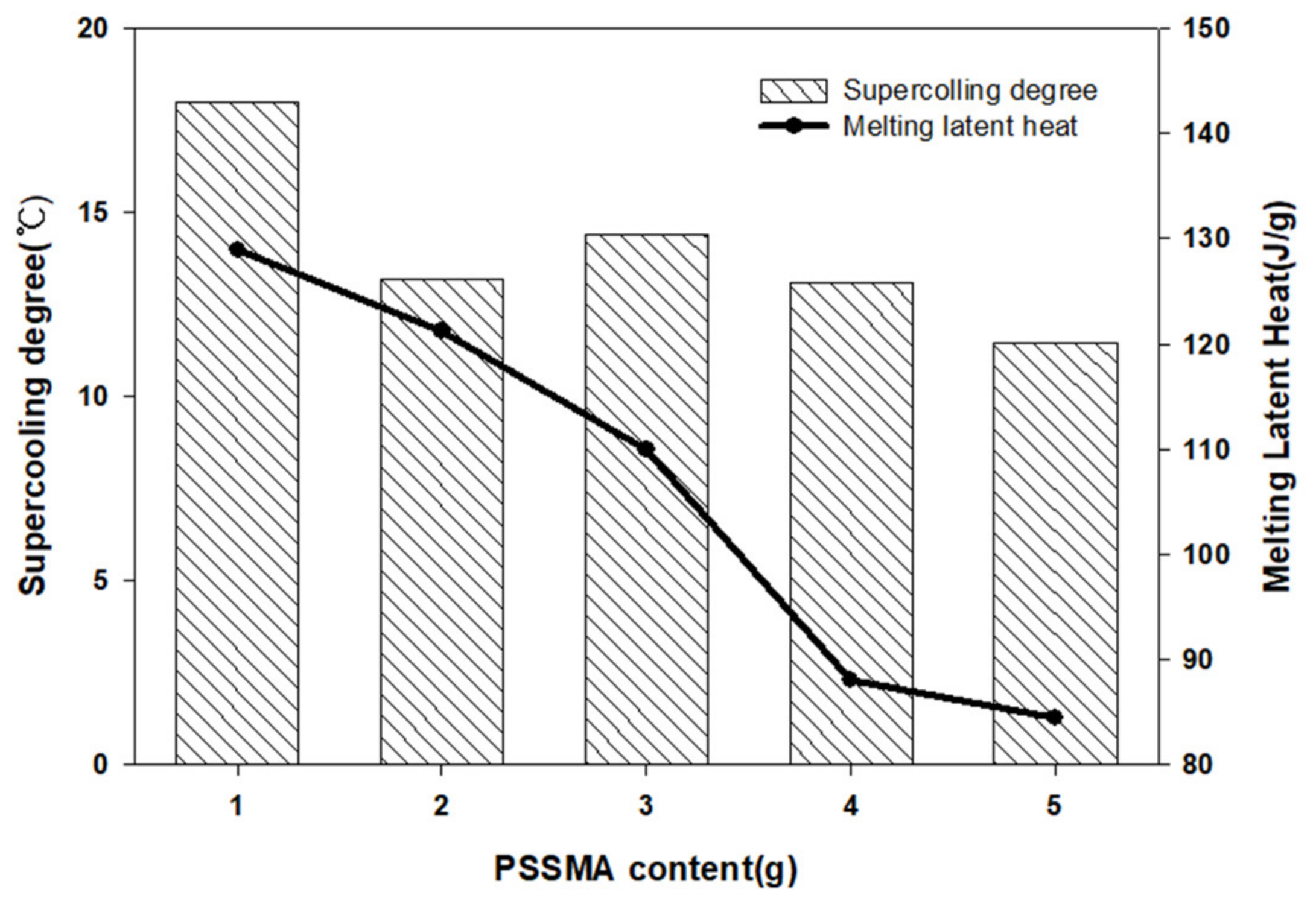Effect of the PSSMA Content on the Heat Transfer Performances of Polyurea Nano-Encapsulated Phase Change Materials
Abstract
:1. Introduction
2. Materials and Methods
2.1. Materials
2.2. Methods
2.2.1. Synthesis of PUA-NEPCMs Using a Miniemulsion System
2.2.2. Characterization
3. Results and Discussion
3.1. Synthetic Route to the PUA-NEPCMs
3.2. Morphological Analysis of the PUA-NEPCMs
3.3. Phase Change Behaviors of the PUA-NEPCMs
3.4. Heat Transfer Performance of the PUA-NEPCMs Upon Variation in the PSSMA Content
4. Conclusions
Supplementary Materials
Author Contributions
Funding
Institutional Review Board Statement
Informed Consent Statement
Data Availability Statement
Acknowledgments
Conflicts of Interest
References
- Geng, X.; Li, W.; Wang, Y.; Lu, J.; Wang, J.; Wang, N.; Li, J.; Zhang, X. Reversible thermochromic microencapsulated phase change materials for thermal energy storage application in thermal protective clothing. Appl. Energy 2018, 217, 281–294. [Google Scholar] [CrossRef]
- Wang, T.; Wang, L.; Bai, L.; Lin, G.; Bu, X.; Liu, X.; Xie, G. Experimental study on the performance of a liquid cooling garment with the application of MEPCMS. Energy Convers. Manag. 2015, 103, 943–957. [Google Scholar] [CrossRef]
- Konuklu, Y.; Ostry, M.; Paksoy, H.O.; Charvat, P. Review on using microencapsulated phase change materials (PCM) in building applications. Energy Build. 2015, 106, 134–155. [Google Scholar] [CrossRef]
- Zhang, H.; Xing, F.; Cui, H.-Z.; Chen, D.-Z.; Ouyang, X.; Xu, S.-Z.; Wang, J.-X.; Huang, Y.-T.; Zuo, J.-D.; Tang, J.-N. A novel phase-change cement composite for thermal energy storage: Fabrication, thermal and mechanical properties. Appl. Energy 2016, 170, 130–139. [Google Scholar] [CrossRef]
- Gao, F.; Wang, X.; Wu, D. Design and fabrication of bifunctional microcapsules for solar thermal energy storage and solar photocatalysis by encapsulating paraffin phase change material into cuprous oxide. Sol. Energy Mater. Sol. Cells 2017, 168, 146–164. [Google Scholar] [CrossRef]
- Liu, H.; Wang, X.; Wu, D. Tailoring of bifunctional microencapsulated phase change materials with CdS/SiO2 double-layered shell for solar photocatalysis and solar thermal energy storage. Appl. Therm. Eng. 2018, 134, 603–614. [Google Scholar] [CrossRef]
- Nomura, T.; Sheng, N.; Zhu, C.; Saito, G.; Hanzaki, D.; Hiraki, T.; Akiyama, T. Microencapsulated phase change materials with high heat capacity and high cyclic durability for high-temperature thermal energy storage and transportation. Appl. Energy 2017, 188, 9–18. [Google Scholar] [CrossRef]
- Sheng, N.; Zhu, C.; Saito, G.; Hiraki, T.; Haka, M.; Hasegawa, Y.; Sakai, H.; Akiyama, T.; Nomura, T. Development of a microencapsulated Al–Si phase change material with high-temperature thermal stability and durability over 3000 cycles. J. Mater. Chem. A 2018, 6, 18143–18153. [Google Scholar] [CrossRef]
- Pethurajan, V.; Sivan, S.; Konatt, A.J.; Reddy, A.S. Facile approach to improve solar thermal energy storage efficiency using encapsulated sugar alcohol based phase change material. Sol. Energy Mater. Sol. Cells 2018, 185, 524–535. [Google Scholar] [CrossRef]
- Di Credico, B.; Levi, M.; Turri, S. An efficient method for the output of new self-repairing materials through a reactive isocyanate encapsulation. Eur. Polym. J. 2013, 49, 2467–2476. [Google Scholar] [CrossRef]
- Ho, C.-J.; Chang, P.-C.; Yan, W.-M.; Amani, M. Microencapsulated n-eicosane PCM suspensions: Thermophysical properties measurement and modeling. Int. J. Heat Mass Transf. 2018, 125, 792–800. [Google Scholar] [CrossRef]
- Park, S.; Lee, Y.; Kim, Y.S.; Lee, H.M.; Kim, J.H.; Cheong, I.W.; Koh, W.-G. Magnetic nanoparticle-embedded PCM nanocapsules based on paraffin core and polyurea shell. Colloids Surf. A Physicochem. Eng. Asp. 2014, 450, 46–51. [Google Scholar] [CrossRef]
- Zhao, A.; An, J.; Yang, J.; Yang, E.-H. Microencapsulated phase change materials with composite titania-polyurea (TiO2-PUA) shell. Appl. Energy 2018, 215, 468–478. [Google Scholar] [CrossRef]
- Wang, X.; Li, C.; Wang, M.; Zhao, T.; Li, W. Bifunctional Microcapsules with n-Octadecane/Thyme Oil Core and Polyurea Shell for High-Efficiency Thermal Energy Storage and Antibiosis. Polymers 2020, 12, 2226. [Google Scholar] [CrossRef]
- Li, C.; Yu, H.; Song, Y.; Liang, H.; Yan, X. Preparation and characterization of PMMA/TiO2 hybrid shell microencapsulated PCMs for thermal energy storage. Energy 2019, 167, 1031–1039. [Google Scholar] [CrossRef]
- Rezvanpour, M.; Hasanzadeh, M.; Azizi, D.; Rezvanpour, A.; Alizadeh, M. Synthesis and characterization of micro-nanoencapsulated n-eicosane with PMMA shell as novel phase change materials for thermal energy storage. Mater. Chem. Phys. 2018, 215, 299–304. [Google Scholar] [CrossRef]
- Mohaddes, F.; Islam, S.; Shanks, R.; Fergusson, M.; Wang, L.; Padhye, R. Modification and evaluation of thermal properties of melamine-formaldehyde/n-eicosane microcapsules for thermo-regulation applications. Appl. Therm. Eng. 2014, 71, 11–15. [Google Scholar] [CrossRef]
- Konuklu, Y.; Paksoy, H.O.; Unal, M.; Konuklu, S. Microencapsulation of a fatty acid with Poly (melamine–urea–formaldehyde). Energy Convers. Manag. 2014, 80, 382–390. [Google Scholar] [CrossRef]
- Ollier, R.P.; Alvarez, V.A. Synthesis of epoxy-loaded poly (melamine-formaldehyde) microcapsules: Effect of pH regulation method and emulsifier selection. Colloids Surf. A Physicochem. Eng. Asp. 2017, 520, 872–882. [Google Scholar] [CrossRef]
- Qiao, Z.; Mao, J. Multifunctional poly (melamine-urea-formaldehyde)/graphene microcapsules with low infrared emissivity and high thermal conductivity. Mater. Sci. Eng. B 2017, 226, 86–93. [Google Scholar] [CrossRef]
- Zhang, L.; Yang, W.; Jiang, Z.; He, F.; Zhang, K.; Fan, J.; Wu, J. Graphene oxide-modified microencapsulated phase change materials with high encapsulation capacity and enhanced leakage-prevention performance. Appl. Energy 2017, 197, 354–363. [Google Scholar] [CrossRef]
- Liu, Z.; Chen, Z.; Yu, F. Microencapsulated phase change material modified by graphene oxide with different degrees of oxidation for solar energy storage. Sol. Energy Mater. Sol. Cells 2018, 174, 453–459. [Google Scholar] [CrossRef]
- Ma, X.; Liu, Y.; Liu, H.; Zhang, L.; Xu, B.; Xiao, F. Fabrication of novel slurry containing graphene oxide-modified microencapsulated phase change material for direct absorption solar collector. Sol. Energy Mater. Sol. Cells 2018, 188, 73–80. [Google Scholar] [CrossRef]
- Li, M.; Chen, M.; Wu, Z. Enhancement in thermal property and mechanical property of phase change microcapsule with modified carbon nanotube. Appl. Energy 2014, 127, 166–171. [Google Scholar] [CrossRef]
- Sarier, N.; Onder, E.; Ukuser, G. Silver incorporated microencapsulation of n-hexadecane and n-octadecane appropriate for dynamic thermal management in textiles. Thermochim. Acta 2015, 613, 17–27. [Google Scholar] [CrossRef]
- Jiang, X.; Luo, R.; Peng, F.; Fang, Y.; Akiyama, T.; Wang, S. Synthesis, characterization and thermal properties of paraffin microcapsules modified with nano-Al2O3. Appl. Energy 2015, 137, 731–737. [Google Scholar] [CrossRef]
- Hong, Y.; Wu, W.; Hu, J.; Zhang, M.; Voevodin, A.A.; Chow, L.; Su, M. Controlling supercooling of encapsulated phase change nanoparticles for enhanced heat transfer. Chem. Phys. Lett. 2011, 504, 180–184. [Google Scholar] [CrossRef]
- Tang, X.; Li, W.; Zhang, X.; Shi, H. Fabrication and characterization of microencapsulated phase change material with low supercooling for thermal energy storage. Energy 2014, 68, 160–166. [Google Scholar] [CrossRef]
- Pickering Emulsion. Available online: https://en.wikipedia.org/w/index.php?title=Pickering_emulsion&oldid=1009886136 (accessed on 4 May 2021).
- Zou, D.; Liu, X.; He, R.; Huang, L. High thermal response rate and super low supercooling degree microencapsulated phase change materials (MEPCM) developed by optimizing shell with various nanoparticles. Int. J. Heat Mass Transf. 2019, 140, 956–964. [Google Scholar] [CrossRef]
- Kiziroglou, M.; Yeatman, E. Protection of electronics from environmental temperature spikes by phase change materials. J. Electron. Mater. 2015, 44, 4589–4594. [Google Scholar] [CrossRef] [Green Version]





| Experimental | n-octadecane (OD, g) | TDI (mM, g) | PSSMA (g) | EDA (mM, g) | DI Water (g) | PUA-NEPCM Size (nm) |
|---|---|---|---|---|---|---|
| PSSMA 1 g | 9.0 | 17.2, 3.0 | 1.0 | 51.6, 3.1 | 130 | 198.5 |
| PSSMA 2 g | 9.0 | 17.2, 3.0 | 2.0 | 51.6, 3.1 | 130 | 195.2 |
| PSSMA 3 g | 9.0 | 17.2, 3.0 | 3.0 | 51.6, 3.1 | 130 | 183.8 |
| PSSMA 4 g | 9.0 | 17.2, 3.0 | 4.0 | 51.6, 3.1 | 130 | 180.9 |
| PSSMA 5 g | 9.0 | 17.2, 3.0 | 5.0 | 51.6, 3.1 | 130 | 177.7 |
| Experimental | Ea (%) | |||||
|---|---|---|---|---|---|---|
| n-octadecane | 32.52 (±0.02) | 21.51 (±0.03) | 11.01 (±0.05) | 230.3 | 233.9 | - |
| PSSMA 1 g | 35.49 (±0.06) | 18.01 (±0.11) | 123.0 | 128.9 | 54.3 | |
| PSSMA 2 g | 33.33 (±0.03) | 20.15 (±0.01) | 13.18 (±0.04) | 119.3 | 121.2 | 51.8 |
| PSSMA 3 g | 33.83 (±0.03) | 19.41 (±0.01) | 14.42 (±0.04) | 104.6 | 110.0 | 46.2 |
| PSSMA 4 g | 32.19 (±0.03) | 19.12 (±0.03) | 13.07 (±0.06) | 82.9 | 88.0 | 36.8 |
| PSSMA 5 g | 32.05 (±0.03) | 20.58 (±0.03) | 11.47 (±0.06) | 78.0 | 84.4 | 35.0 |
Publisher’s Note: MDPI stays neutral with regard to jurisdictional claims in published maps and institutional affiliations. |
© 2021 by the authors. Licensee MDPI, Basel, Switzerland. This article is an open access article distributed under the terms and conditions of the Creative Commons Attribution (CC BY) license (https://creativecommons.org/licenses/by/4.0/).
Share and Cite
Kook, J.-W.; Hwang, K.; Lee, J.-Y. Effect of the PSSMA Content on the Heat Transfer Performances of Polyurea Nano-Encapsulated Phase Change Materials. Materials 2021, 14, 3157. https://doi.org/10.3390/ma14123157
Kook J-W, Hwang K, Lee J-Y. Effect of the PSSMA Content on the Heat Transfer Performances of Polyurea Nano-Encapsulated Phase Change Materials. Materials. 2021; 14(12):3157. https://doi.org/10.3390/ma14123157
Chicago/Turabian StyleKook, Jun-Won, Kiseob Hwang, and Jun-Young Lee. 2021. "Effect of the PSSMA Content on the Heat Transfer Performances of Polyurea Nano-Encapsulated Phase Change Materials" Materials 14, no. 12: 3157. https://doi.org/10.3390/ma14123157







